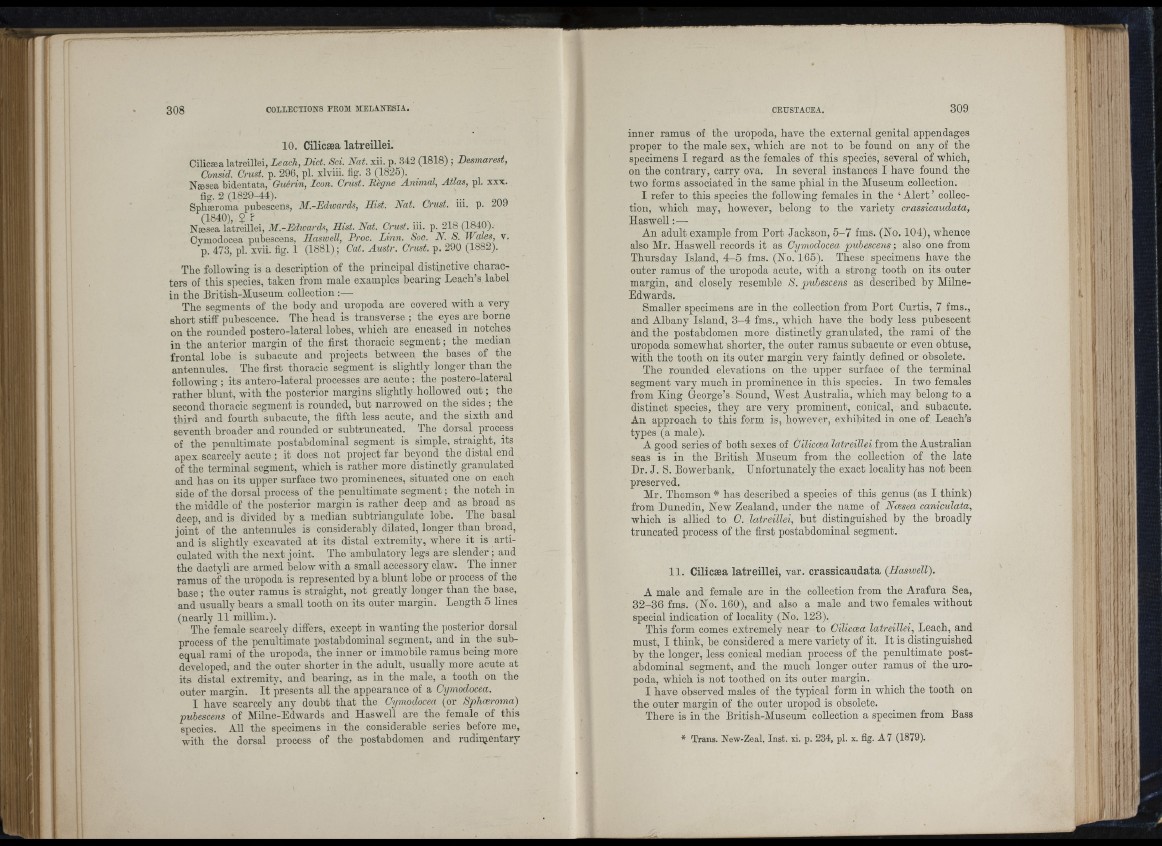
308 COLLECTIONS FROM MELANESIA.
10. Cilicæa latreillei.
Cilicæa latreillei, Leach, Diet. Sci. Nat. xii. p. 342 (1818) ; Desmarest,
Consid. Crust, p. 296, pi. xlviii. fig. 3 (1825).
Næsea bidentata, Guérin, Icon. Crust. Règne Animal, Atlas, pi. xxx.
tig. 2 (1829-44).
Spliseroma pubescens, M.-Edwards, Hist. Nat. Crust, in. p. -^09
Næsea latreillei, M.-Edwards, Hist. Nat. Crust, iii. p. 218 (1840).
Cymodocea pubescens, Haswell, Proc. Linn. Soc. N. S. Wales, v.
"p. 473, pi. xvii. fig. 1 (1881) ; Cat. Austr. Crust, p. 290 (1882).
The following is a description of the principal distinctive characters
of this species, taken from male examples bearing Leach’s label
in the British-Aluseum collection :—
The segments of the body aud uropoda are covered with a very
short stiff pubescence. The head is transverse ; the eyes are borne
on the rounded postero-lateral lobes, which are encased in notches
in the anterior margin of the first thoracic segment ; the median
frontal lobe is suhacute and projects between the bases of the
antennules. The first thoracic segment is slightly longer than the
following ; its antero-lateral processes are acute : the postero-lateral
rather blunt, with the posterior margins slightly hollowed out ; the
second thoracic segment is rounded, but narrowed on the sides ; the
third and fourth suhacute, the fifth less acute, and the sixth and
seventh broader and rounded or suhtruncated. The dorsal process
of the penultimate postahdominal segment is simple, straight, its
apex scarcely acute ; it does not project far beyond the distal end
of the terminal segment, which is rather more distinctly granulated
and has on its upper surface two prominences, situated one on each
side of the dorsal process of the penultimate segment ; the notch in
the middle of the posterior margin is rather deep and as broad as
deep, and is divided by a median subtriangulate lobe. The hasal
joint of the antennules is considerably dilated, longer thau_broad,
and is slightly excavated at its distal extremity, where it is articulated
with the next joint. Tho ambulatory legs are slender and
the dactyli are armed below with a small accessory claw. The inner
ramus of the uropoda is represented by a blunt lobe or process of the
base ; the outer ramus is straight, not greatly longer than the base,
and usually bears a small tooth on its outer margin. Length 5 lines
(nearly 11 millim.).
The female scarcely differs, except in wanting the posterior dorsal
process of the penultimate postahdominal segment, and in the subequal
rami of the uropoda, the inner or immobile ramus being more
developed, and the outer shorter in the adult, usually more acute at
its distal extremity, and hearing, as in the male, a tooth on the
outer margin. I t presents all the appearance of a Cymodocea.
I have scarcely any doubt th a t the Cymodocea (or Sphceroma)
pubescens of Alilne-Edwards and Haswell are the female of this
species. All the specimens in the considerable series before me,
with the dorsal process of the postahdomen and rudinjentary
CRUSTACEA, 309
inner ramus of the uropoda, have the external genital appendages
proper to the male sex, which are not to he found on any of the
specimens I regard as the females of this species, several of which,
on the contrary, carry ova. In several instances I have found the
two forms associated in the same phial in the Museum collection.
I refer to this species the following females in the ‘ Alert ’ collection,
which may, however, belong to the variety crassicaudata,
Haswell;—■
An adult example from Port Jackson, 5 -7 fms. (No. 104), whence
also Air. Haswell records it as Cymodocea pubescens; also one from
Thursday Island, 4 -5 fms. (No. 165). These specimens have the
outer ramus of the uropoda acute, with a strong tooth on its outer
margin, and closely resemble S. qmbescens as described by Milne-
Edwards.
Smaller specimens are in the collection from Port Curtis, 7 fms.,
and Albany Island, 3 -4 fms., which have the body less pubescent
and the postahdomen more distinctly granulated, tho rami of the
uropoda somewhat shorter, the outer ramus suhacute or even obtuse,
with the tooth on its outer margin very faintly defined or obsolete.
The rounded elevations on the upper surface of the terminal
segment vary much in prominence in this species. In two females
from King George’s Sound, AVest Australia, which may belong to a
distinct species, they are very prominent, conical, and subacute.
An approach to this form is, however, exhibited in one of Leach’s
types (a male).
A good series of both sexes of Ciliccea latreillei from the Australian
seas is in the British Alusenm from the collection of the late
Dr. J. S. Bowerhank. Unfortunately the exact locality has not been
preserved.
Air. Thomson * has described a species of this genus (as I think)
from Dunedin, New Zealand, under the name of Ncesea caniculata,
which is allied to C. latreillei, but distinguished by the broadly
truncated process of the first postahdominal segment.
I I . Cilicaea latreillei, var. crassicaudata {Haswell).
A male and female are in the collection from the Arafura Sea,
32-36 fms. (No. 160), and also a male and two females without
special indication of locality (No. 123).
This form comes extremely near to Ciliccea latreillei, Leach, and
must, I think, he considered a mere variety of it. I t is distinguished
by the longer, less conical median process of the penultimate postahdominal
segment, and the much longer outer ramus of the uropoda,
which is not toothed on its outer margin.
I have observed males of the tjqncal form in which the tooth on
the outer margin of the outer uropod is obsolete.
There is in the British-Museum collection a specimen from Bass
, I
V !■ I
i
!
Hit